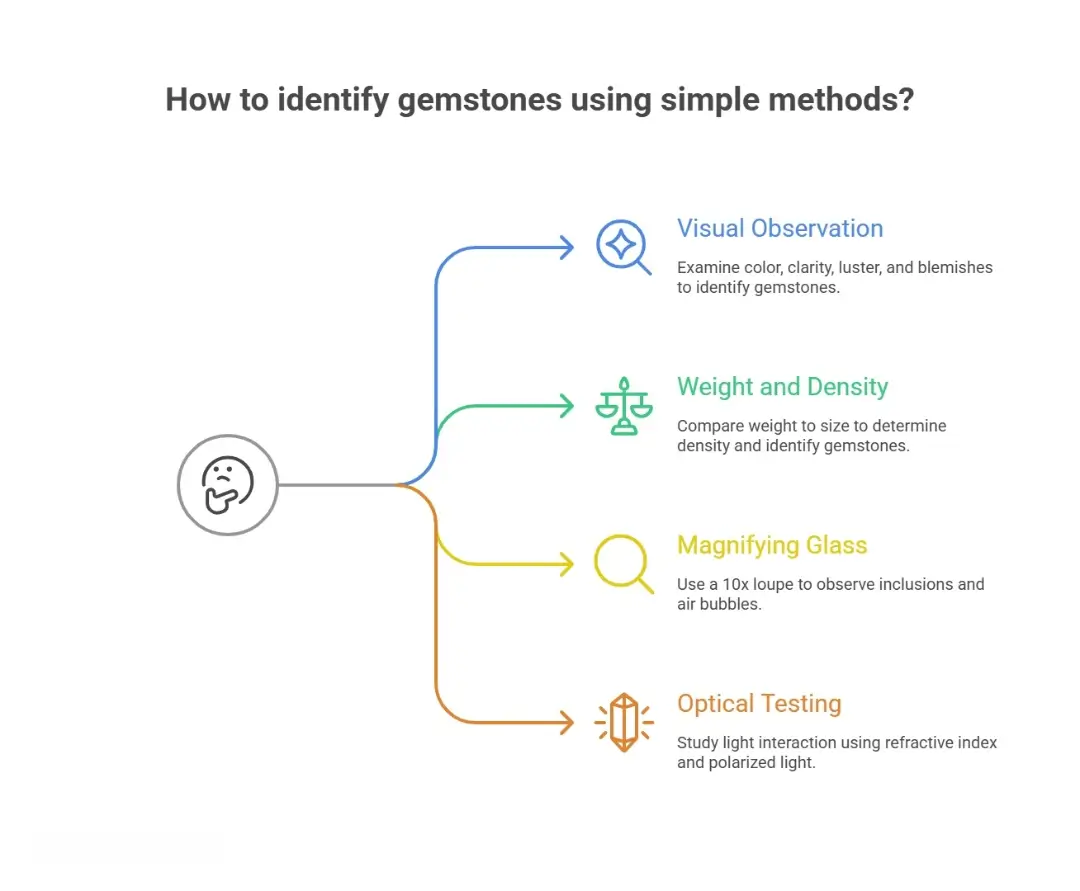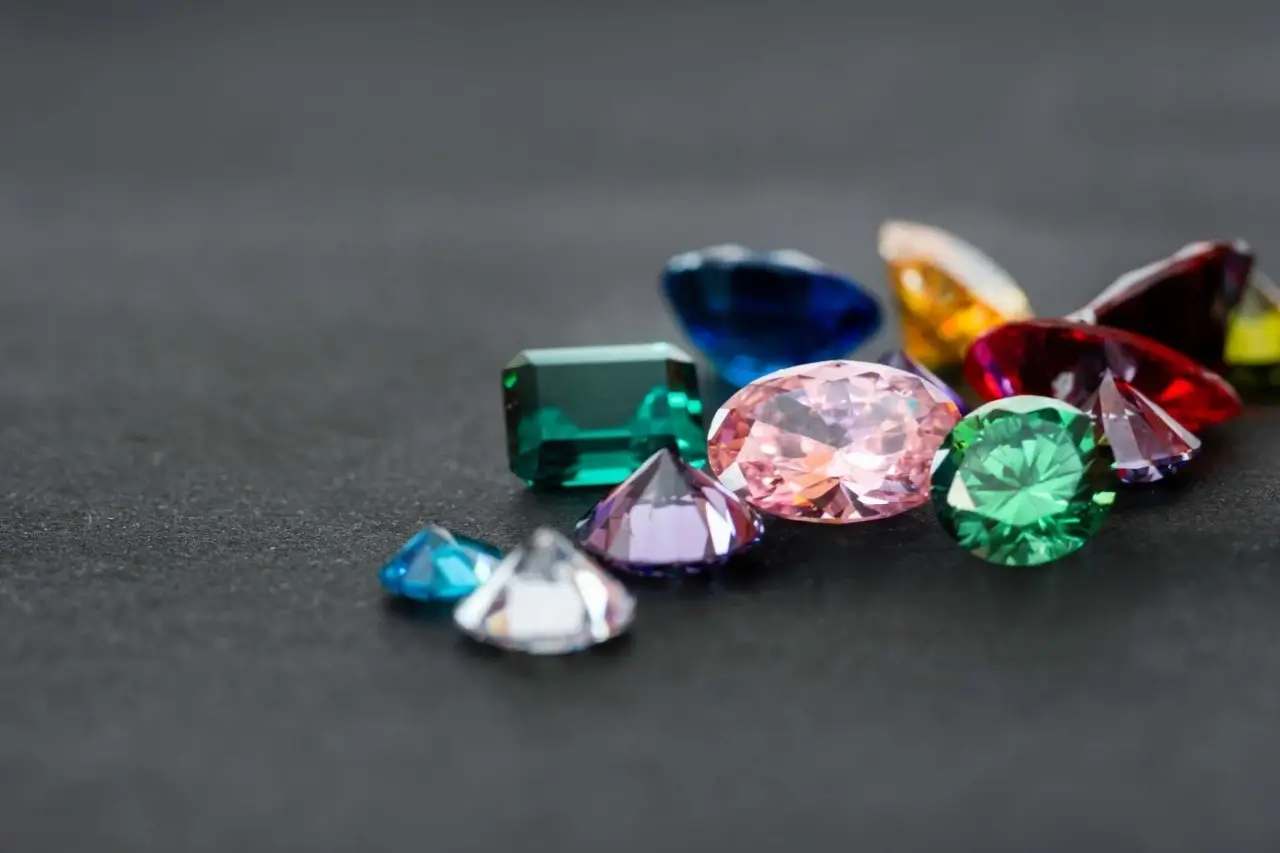Gemstone identification is a rewarding skill for anyone passionate about jewelry, whether you’re a hobbyist, collector, or simply shopping for a special piece. With genuine and imitation gems flooding the market, distinguishing between them can be challenging. This guide introduces the basics of gemstone identification, equipping you with practical tools to make informed judgments about a stone’s authenticity.
What is Gemstone Identification?
Gemstone identification involves determining a stone’s identity through visual inspection and simple tests. For beginners, the aim isn’t to become a certified gemologist overnight but to recognize key traits that hint at a gem’s nature. While professionals rely on advanced equipment for definitive results, you can learn to spot telltale signs with minimal tools. Common gemstones you might encounter include:
- Diamonds: Prized for their brilliance and unmatched hardness.
- Rubies: Known for their rich, deep red hue.
- Sapphires: Available in various colors, most famously blue.
- Emeralds: Cherished for their vibrant green tones.
- Jade: Popular in jewelry and carvings, often imitated.
Simple Identification Methods for Beginners
You don’t need costly tools to start identifying gemstones. A keen eye and a few affordable items can go a long way.

Visual Observation
Begin by examining the stone closely, noting its unique characteristics:
- Color: A gem’s hue and saturation offer vital clues. For instance, a natural ruby often has subtle color variations, while a synthetic one may appear unnaturally uniform.
- Clarity: Most natural gemstones contain inclusions—tiny flaws or crystals trapped inside. A stone that looks flawless might be synthetic, as perfect natural gems are rare.
- Luster: Observe how light reflects off the surface. Does it have a glassy, waxy, or metallic sheen? A diamond’s sparkle, for example, differs noticeably from cubic zirconia’s.
- Blemishes: Check for scratches or chips. Since gemstones vary in hardness, a fake might show wear that a genuine stone resists.
Weight and Density
Comparing a stone’s weight to its size can reveal its identity. Density, or mass per unit volume, varies between materials. For example, a ruby is denser than glass, so a genuine ruby will feel heavier than a glass imitation of the same size.
Magnifying Glass and Microscopic Observation
A 10x jeweler’s loupe is a beginner’s best friend for gemstone identification. It reveals details invisible to the naked eye:
- Inclusions: These internal “fingerprints” confirm a stone’s natural origin. Synthetic gems often lack such imperfections.
- Air Bubbles: Round air bubbles are a hallmark of glass or man-made materials, rarely seen in natural gemstones.
Optical Testing
For a slightly advanced approach, study how light interacts with the stone. Each gem has a unique refractive index (RI), which measures how light bends as it passes through. A refractometer can quantify this, but even without one, you can use a polarized light filter to check if a stone is singly or doubly refractive. While these tests require specialized tools, understanding the principles lays a strong foundation for beginners.
Common Misconceptions and Pitfalls
When you’re learning how to identify gemstones, watch out for these common traps:
- “Brighter colors mean authenticity.” Not always. High-quality synthetic gems can mimic the vividness of natural stones, sometimes appearing too perfect.
- Unreliable quick tests. Avoid dubious methods like flame tests or biting a stone to gauge hardness. These can damage genuine gems and yield inaccurate results.
- Deceptive practices. Some sellers pass off synthetic gems as natural or enhance low-quality stones to boost their appearance. Stay vigilant for these tricks.
When to Consult a Professional
While DIY identification is empowering, certain situations call for expert input:
- High-value stones: If you’re eyeing an expensive gem or suspect you’ve found a rare one, professional verification is essential.
- Investments or collections: Authentication from a reputable lab, like the Gemological Institute of America (GIA), adds credibility and value to your gem.
Recommended Tools and Resources for Beginners
A few affordable tools can elevate your gemstone identification skills:
- 10x Magnifying Glass: A jeweler’s loupe is essential for inspecting a stone’s surface and interior.
- Gemstone Tweezers: These allow safe handling without scratching the stone or leaving fingerprints.
- Hardness Testing Tools: A basic set of Mohs Hardness Testing Pencils helps test a gem’s resistance to scratching, which is a key identification factor.
For deeper learning, explore gemology books or online courses from trusted sources. At JYBS, we offer reliable jewelry tools, including precision magnifiers and professional tweezers, to support your gemstone identification journey with confidence.
Conclusion
Mastering gemstone identification takes time, but every expert was once a beginner. By starting with visual observation, weight comparison, and tools like a magnifying glass, you can build a strong foundation. As you gain experience, explore advanced techniques, but always seek professional verification for valuable stones. With practice, you’ll develop a sharp eye for spotting the real deal. Happy gem hunting!

